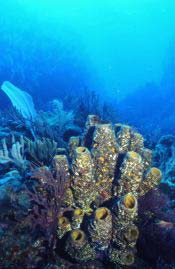Conservationists Identify Marine Biodiversity "Hotspots"

Image: ©Science/Photo by Callum Roberts
Conservation-oriented parks and reserves are fairly common on land, but comparatively few marine regions receive protection from human activities. This situation has, for the most part, elicited little concern, owing to the widely held belief that the large geographic ranges of most marine species would ensure their survival. But new research on restricted-range marine life—that is, species limited to small areas—challenges that idea, identifying 10 regions where further damage to coral reefs could lead to a series of extinctions. According to the authors of a study published today in the journal Science, conservation efforts directed at these so-called hotspots could prevent such extinctions and preserve marine biodiversity.
The researchers, led by Callum Roberts of the University of York, analyzed the geographic distributions of 3,235 different species of reef fish, coral, snail and lobster. More than a quarter of the fish and snail species and more than half of the lobsters have restricted ranges, they report. (Only 7.2 percent of the corals appear to have restricted ranges, but the investigators caution that they may well have underestimated coral biodiversity.) Taking these results into consideration along with those of a previous study, the team identified the ocean’s most threatened reefs and pinpointed the 10 biodiversity hotspots. Although these areas comprise only 0.012 percent of the oceans, they harbor 34 percent of restricted-range species. The researchers note that the Philippines and the Gulf of Guinea are the top two hotspots. Some of the areas might be best served by joint protection plans, as eight of the 10 marine hotspots adjoin terrestrial ones. In these cases, the authors prescribe an extension of conservation efforts from land to sea.
Media Contact
All latest news from the category: Ecology, The Environment and Conservation
This complex theme deals primarily with interactions between organisms and the environmental factors that impact them, but to a greater extent between individual inanimate environmental factors.
innovations-report offers informative reports and articles on topics such as climate protection, landscape conservation, ecological systems, wildlife and nature parks and ecosystem efficiency and balance.
Newest articles

A universal framework for spatial biology
SpatialData is a freely accessible tool to unify and integrate data from different omics technologies accounting for spatial information, which can provide holistic insights into health and disease. Biological processes…

How complex biological processes arise
A $20 million grant from the U.S. National Science Foundation (NSF) will support the establishment and operation of the National Synthesis Center for Emergence in the Molecular and Cellular Sciences (NCEMS) at…

Airborne single-photon lidar system achieves high-resolution 3D imaging
Compact, low-power system opens doors for photon-efficient drone and satellite-based environmental monitoring and mapping. Researchers have developed a compact and lightweight single-photon airborne lidar system that can acquire high-resolution 3D…





















